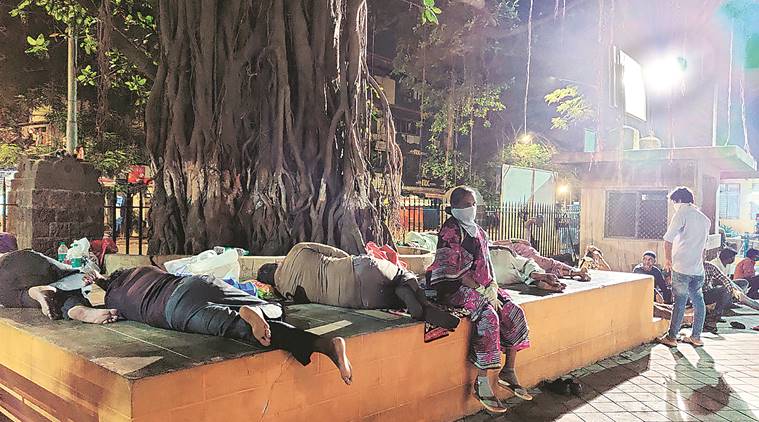 Outside KEM Hospital, which is at the frontline of Mumbai’s Covid battle. (Express photo by Tabassum Barnagarwala)
Outside KEM Hospital, which is at the frontline of Mumbai’s Covid battle. (Express photo by Tabassum Barnagarwala)
It is past midnight, but the three dozen men and women on the pavement outside the KEM Hospital are wide awake. From beneath the banyan tree, they fix their gaze on the emergency ward, waiting for beds to empty.
At the frontline of Mumbai’s battle against the pandemic, the 95-year-old hospital, where nearly 400 of 1,800 beds are reserved for Covid patients, is swamped by patients with all kinds of other health complaints and illnesses.
Coronavirus India LIVE Updates
Not only does it draw people from neighbouring districts, it also caters to a huge slum population, including Worli, the first containment zone in the city. One of the few hospitals treating both Covid, non-Covid patients, it is the choice of many because private hospitals are too scared to admit them.
On an average, an estimated 120 people with cough, cold, fever complaints visit the hospital, and 40 get admitted.
Dr Hemant Deshmukh, Dean of KEM Hospital, says, “Most patients start coming evening onward. And at night, they have no means to go home, so they stay back, hoping a bed will get free.”
The crowd of patients has thickened after the nearby Nair Hospital, a municipal facility, converted into a Covid hospital. All non-Covid patients are referred to KEM. With private hospitals running skeletal OPD services, KEM has become the final port of call.
“As a policy, we have decided not to refuse treatment to anyone. If we don’t take them in, who will?” says Deshmukh.
But the challenges at night are different — there are fewer staffers to deal with desperate families.
An intern at the front desk of the emergency medical services (EMS) says from the time his shift began at 8 pm, he had taken down names of 53 people until midnight. All with Covid-like symptoms. Most people, he says, were given medication and sent home since beds are not available.
Khatoon Shaikh, a patient with a heart condition, waited 10 hours to get admission. Turned away from four hospitals, she finally reached KEM Hospital. And she now waits, sitting on a bedsheet spread on the stone floor.
Her son Rafiq says he has filled several forms, visited different departments. Given there are suspected Covid patients in the hospital, he thinks it is safer that his mother waits outside.
Inside the emergency ward, doctors are wearing blue personal protective equipment, only their eyes visible behind glasses.
Upon entry, each patient is asked, “Do you have fever, cough, cold or breathlessness?” These are Covid symptoms. Suspected cases are transferred to two wards, with 50 beds each, next.
Through the night, the wait for a hospital bed to the emergency ward. They are full, so patients sit in the corridor as they await test results. Once the corridor fills up, people move outside.
A young resident doctor asks them to make way. It feels inhuman, he says, to send patients out, but the ward remains high-risk. Three of his colleagues have tested positive.
“Earlier, the emergency ward used to be this crowded only on a Monday. Now it’s every day,” the doctor says.
Another doctor, attached to the gynaecology ward, says, “Before the pandemic, we did 15-20 deliveries a day, now the number is 30. All private hospitals are scared to admit patients.” A day earlier, there were 16 deliveries during an eight-hour shift.
Around 1 am, a car pulls up outside the emergency ward. Four men place an elderly man on a wheelchair and wheel him up the ramp. The intern asks the man if he has fever, cough or cold. He does not reply. The intern checks his pulse. “He is, I think, no more. Please take him to that counter,” he says.
The counter has three doctors, all seated behind a rope, two feet away. The shocked family insists that they treat him: “How can he suddenly die?” The man is identified as Shankar Chaurase.
As paperwork begins for Chaurase, two bodies, sealed in black cases, are wheeled out by men in PPEs.
Outside, Sangeeta More starts weeping as she looks at the bodies. Her husband Subash More (60) is gasping on a stretcher. He is diabetic. Her son Umesh rushes out of the emergency ward, “They are all wearing PPEs. the ward is full of corona patients. Let’s go to another hospital, we will catch infection here,” he says.
The intern follows him. “You have to let us check him, stabilise him,” he tells the son. When the man refuses, the intern makes him a sign a form of discharge against medical advice. “We try to counsel, but there are so many patients,” says the intern.
The night shift is far from over.